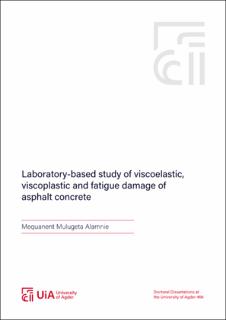| dc.contributor.advisor | Taddesse, Ephrem | |
| dc.contributor.advisor | Hoff, Inge | |
| dc.contributor.author | Alamnie, Mequanent Mulugeta | |
| dc.date.accessioned | 2024-04-16T09:59:53Z | |
| dc.date.available | 2024-04-16T09:59:53Z | |
| dc.date.created | 2024-04-15T15:29:34Z | |
| dc.date.issued | 2024 | |
| dc.identifier.citation | Alamnie, M. M. (2024). Laboratory-based study of viscoelastic, viscoplastic and fatigue damage of asphalt concrete [Doctoral dissertation]. University of Agder. | en_US |
| dc.identifier.isbn | 978-82-8427-183-5 | |
| dc.identifier.issn | 1504-9272 | |
| dc.identifier.uri | https://hdl.handle.net/11250/3126749 | |
| dc.description.abstract | Asphalt concrete is one of the most important road building materials worldwide. This material exhibits unique chemical, physical and mechanical properties. The most well-known mechanical properties are the viscoelastic, viscoplastic-viscodamage (deformability), fatigue cracking, and fracture under different environmental and loading scenarios. The investigation of bituminous mixtures focuses on four main properties; stiffness and stiffness change, fatigue and damage law evolution, permanent deformation and accumulation at high temperatures, and cracks and crack propagation at low temperatures. Every mechanistic-empirical (ME) and mechanistic pavement design method attempts to model and simulate these four properties for an accurate performance prediction. The main contributions of this research project are focused on the linear viscoelastic and damage responses of asphalt concrete mixtures. This thesis presents the uniaxial and triaxial viscoelastic responses and the interaction between the permanent deformation and uniaxial cyclic fatigue responses of asphalt concrete mixtures. To achieve these objectives, extensive laboratory investigations were performed using the latest mechanistic asphalt testing equipment. The linear viscoelastic (LVE) properties of asphalt concrete are crucial for mechanistic pavement design. The rutting and fatigue cracking properties of asphalt concrete are directly correlated with the LVE stiffness. In the first phase, the research emphasized the LVE response in both uniaxial and triaxial states, as well as the axial and indirect tensile (IDT) testing modes. Three of the appended papers extensively addressed these properties. The important conclusions from this phase were the triaxiality of the LVE properties at intermediate and high temperatures, and the good correlation of the IDT and axial mode of the stiffness tests at low and intermediate temperatures but not at high temperatures. The second phase of the study was devoted to the damage responses of asphalt concrete. Permanent deformation (viscoplastic-viscodamage) was investigated at high temperatures (both uniaxial and triaxial), and the cyclic fatigue damage was studied at lower temperatures. The results are reported in three appended papers. A thorough investigation of the inherent damage interaction in asphalt concrete has been conducted in this thesis, which has not been done before. Based on the extensive literature review and our observations and experiments, the permanent deformation - fatigue damage interaction sequence dominates the asphalt concrete damage mechanism. This study applied both continuum damage mechanics (CDM) and dissipated energy (DE) approaches to assess the interaction. The existing prediction models have missed the interaction damage mechanism. It is observed that the myth of rutting-fatigue interaction is interrelated. This research confirms that rutting, apart from thermal cracking, is the cause of surface cracking. This observation further confirms the need for a unified damage model for accurate pavement performance prediction. | en_US |
| dc.language.iso | eng | en_US |
| dc.publisher | University of Agder | en_US |
| dc.relation.ispartofseries | Doctoral dissertations at University of Agder; no. 466 | |
| dc.relation.haspart | Paper I: Alamnie, M. M., Taddesse, E. & Hoff, I (2022). Advances in Permanent Deformation Modeling of Asphalt Concrete - A Review. Materials, 15(10), 3480. https://doi.org/10.3390/ma15103480. Published version. Full-text is available in AURA as a separate file: https://hdl.handle.net/11250/3013098. | en_US |
| dc.relation.haspart | Paper II: Alamnie, M. M., Taddesse, E. & Hoff, I. (2022). Thermo-piezo-rheological characterization of asphalt concrete. Construction and Building Materials, 329: 127106. https://doi.org/10.1016/j.conbuildmat.2022.127106. Published version. Full-text is available in AURA as a separate file: https://hdl.handle.net/11250/3047324. | en_US |
| dc.relation.haspart | Paper III: Alamnie, M. M., Taddesse, E. & Hoff, I. (2021). Viscoelastic characterization and comparison of Norwegian asphalt mixtures using dynamic modulus and IDT tests. In I. Hoff, H. Mork & R. Saba (Eds.), Eleventh International Conference on the Bearing Capacity of Roads, Railways and Airfields (vol. 1, pp. 118-128). CRC Press. https://doi.org/10.1201/9781003222880-12. Published version. Full-text is available in AURA as a separate file: . | en_US |
| dc.relation.haspart | Paper IV: Alamnie, M. M., Taddesse, E. & Hoff, I. (2022). Permanent deformation and fatigue damage interaction in asphalt concrete using energy approach. In I. Hoff, R. Saba & H. Mork (Eds.), Eleventh International Conference on the Bearing Capacity of Roads, Railways and Airfields (vol. 3, pp. 118-127). CRC Press. https://doi.org/10.1201/9781003222910-12. Published version. Full-text is available in AURA as a separate file: https://hdl.handle.net/11250/3066728. | en_US |
| dc.relation.haspart | Paper V: Alamnie, M. M., Taddesse, E. & Hoff, I. (2023). A study on Permanent Deformation and Fatigue Damage Interaction in Asphalt Concrete. Construction and building materials, 407: 133473. https://doi.org/10.1016/j.conbuildmat.2023.133473. Published version. Full-text is available in AURA as a separate file: . | en_US |
| dc.relation.haspart | Paper VI: Chen, H., Alamnie, M. M., Barbieri, D. M., Zhang, X., Liu, G. & Hoff, I. (2022). Comparative study of indirect tensile test and uniaxial compression test on asphalt mixtures : Dynamic modulus and stress-strain state. Construction and Building Materials, 366: 130187. https://doi.org/10.1016/j.conbuildmat.2022.130187. Published version. Full-text is available in AURA as a separate file: https://hdl.handle.net/11250/3041143. | en_US |
| dc.rights | Attribution-NonCommercial-NoDerivatives 4.0 Internasjonal | * |
| dc.rights.uri | http://creativecommons.org/licenses/by-nc-nd/4.0/deed.no | * |
| dc.title | Laboratory-based study of viscoelastic, viscoplastic and fatigue damage of asphalt concrete | en_US |
| dc.type | Doctoral thesis | en_US |
| dc.description.version | publishedVersion | en_US |
| dc.rights.holder | © 2023 Mequanent Mulugeta Alamnie | en_US |
| dc.subject.nsi | VDP::Teknologi: 500 | en_US |
| dc.source.pagenumber | 223 | en_US |
| dc.source.issue | 466 | en_US |
| dc.identifier.cristin | 2261793 | |







